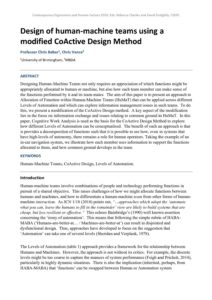| Document | Author Professor Chris Baber, Chris Vance |
| Abstract Designing Human-Machine Teams not only requires an appreciation of which functions might be appropriately allocated to human or machine, but also how each team member can make sense of the functions performed by it and its team-mates. The aim of this paper is to present an approach to Allocation of Function within Human-Machine Teams (HuMaT) that can be applied across different Levels of Automation and which can explore information management issues in such teams. To do this, we present a modification of the CoActive Design method. A key aspect of the modification lies in the focus on information exchange and issues relating to common ground in HuMaT. In this paper, Cognitive Work Analysis is used as the basis for the CoActive Design Method to explore how different Levels of Automation can be conceptualised. The benefit of such an approach is that is provides a decomposition of functions such that it is possible to see how, even in systems that have high-levels of autonomy, there remains a role for human operators. Taking the example of an in-car navigation system, we illustrate how each member uses information to support the functions allocated to them, and how common ground develops in the team. |

